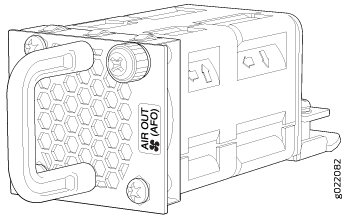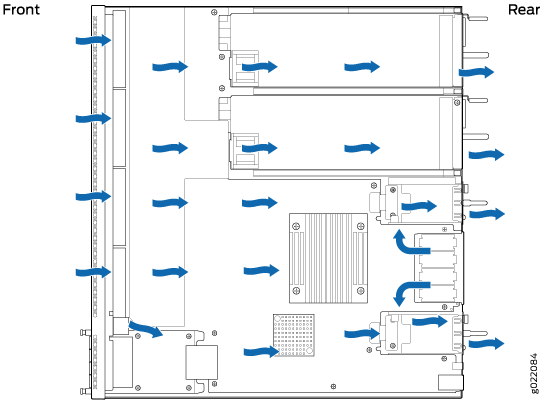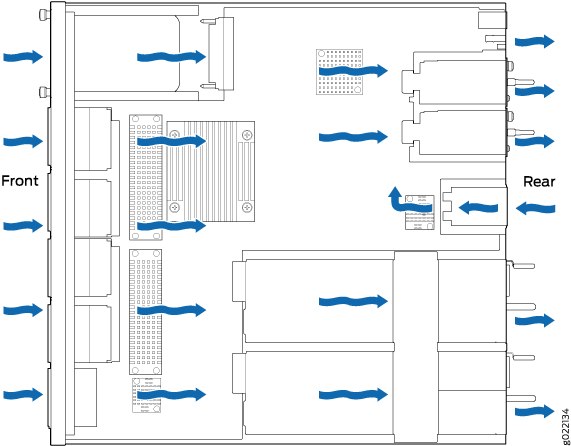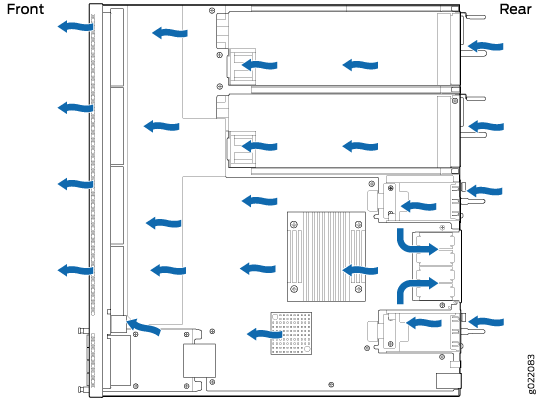Cooling System and Airflow in an EX4300 Switch
The cooling system in an EX4300 switch consists of two fan modules and a single fan in each power supply. EX4300 switches provide back-to-front airflow (air enters through the back of the switch), indicated by the label AIR IN (AFI), or front-to-back (air exhausts through the back of the switch), indicated by the label AIR OUT (AFO)—depending on the fan modules and power supplies installed in the switch.
This topic describes:
Fan Modules
In the EX4300 switches the fan modules are hot-insertable and hot-removable field-replaceable units (FRUs).
All the EX4300 switches, except EX4300-24T-S, EX4300-24P-S, EX4300-32F-S, EX4300-48T-S, and EX4300-48P-S switches are shipped with two fan modules pre-installed in the rear panel of the switch. EX4300-24T-S, EX4300-24P-S, EX4300-32F-S, EX4300-48T-S, and EX4300-48P-S switches are not shipped with pre-installed fan modules; you must order them separately. Each switch can accommodate two fan modules in the fan module slots on the rear panel of the switch. The fan module slots are numbered 0 and 1 and each slot has a fan icon next to it.
Figure 1 shows the fan module used in an EX4300 switch:

You must remove only one fan module at a time for replacement from the rear panel of the chassis. The switch continues to operate for a limited period of time (30 seconds) during the replacement of the fan module without thermal shutdown.
Both the fan modules must be installed for optimal functioning of the switch.
The fan modules are available in two models that have different airflow directions—back-to-front (air enters through the back of the switch), indicated by label AIR IN (AFI), and front-to-back (air exhausts through the back of the switch), indicated by label AIR OUT (AFO). Table 1 lists the available fan module models and the direction of airflow in them.
|
Fan Module |
Label on the Fan Module |
|---|---|
|
EX4300-FAN |
AIR OUT (AFO) |
|
EX4300-FAN-AFI |
AIR IN (AFI) |
Airflow Direction in EX4300 Switch Models
Table 2 shows the direction of airflow in EX4300 switch models as shipped.
|
Model Number |
Fan Modules and Power Supply |
Direction of Airflow |
|---|---|---|
|
The switch ships with two fan modules and an AC power supply, each with a label AIR OUT (AFO). |
Front-to-back—that is, air intake to cool the chassis is through the vents on the front panel of the chassis and hot air exhausts through the vents on the rear panel of the chassis. |
|
The switch ships with two fan modules and a DC power supply, each with a label AIR OUT (AFO). |
Front-to-back—that is, air intake to cool the chassis is through the vents on the front panel of the chassis and hot air exhausts through the vents on the rear panel of the chassis. |
|
EX4300-48T-AFI |
The switch ships with two fan modules and an AC power supply, each with a label AIR IN (AFI). |
Back-to-front—that is, air intake to cool the chassis is through the vents on the rear panel of the chassis and hot air exhausts through the vents on the front panel of the chassis. |
|
EX4300-48T-DC-AFI |
The switch ships with two fan modules and a DC power supply, each with a label AIR IN (AFI). |
Back-to-front—that is, air intake to cool the chassis is through the vents on the rear panel of the chassis and hot air exhausts through the vents on the front panel of the chassis. |
Do not mix:
-
AC and DC power supplies in the same chassis
-
Power supplies and fan modules with different airflow labels (AIR IN (AFI) and AIR OUT (AFO)) in the same chassis
-
Fan modules with different airflow labels (AIR IN (AFI) and AIR OUT (AFO)) in the same chassis.
-
Power supplies and fan modules with different airflow labels (AIR IN (AFI) and AIR OUT (AFO)) in the same chassis.
Front-to-Back Airflow
In the EX4300 switch models that have front-to-back airflow, the air intake to cool the chassis is through the vents on the front panel of the switch and hot air exhausts through the vents on the rear panel. See Figure 2 and Figure 3.


You must install only power supplies that have AIR OUT (AFO) labels in switches in which the fan modules have AIR OUT (AFO) labels.
Back-to-Front Airflow
In the EX4300 switch models that have back-to-front airflow, the air intake to cool the chassis is through the vents on the rear panel and hot air exhausts through the vents on the front panel of the switch. See Figure 4.

You must install only power supplies that have AIR IN (AFI) labels in switches in which the fan modules have AIR IN (AFI) labels.
Do Not Mix AIR IN (AFI) and AIR OUT (AFO) Components in the Switch
Do not mix power supplies and fan modules with different airflow labels (AIR IN (AFI) and AIR OUT (AFO)) in the same chassis. If the fan modules have AIR IN (AFI) labels, the power supplies must also have AIR IN (AFI) labels; if the fan modules have AIR OUT (AFO) labels, the power supplies must also have AIR OUT (AFO) labels.
The labels on the power supplies and fan modules should match the labels on the switch chassis.
Mixing components with AIR IN (AFI) and AIR OUT (AFO) labels in the same chassis hampers the performance of the cooling system of the switch and leads to overheating of the chassis.
The system raises an alarm if a fan module fails or if the ambient temperature inside the chassis rises above the acceptable range. If the temperature inside the chassis rises above the threshold temperature, the system shuts down automatically.
Positioning the Switch
In front-to-back airflow, indicated by the label AIR OUT (AFO) on the fan modules and power supplies, hot air exhausts through the vents on the rear panel of the switch. In back-to-front airflow, indicated by the label AIR IN (AFI) on the fan modules and power supplies, hot air exhausts through the vents on the front panel of the switch.
In data center deployments, position the switch in such a manner that the AIR IN (AFI) labels on switch components are next to the cold aisle, and AIR OUT (AFO) labels on switch components are next to the hot aisle.
Fan Module Status
Each switch has a status LED for each fan module next to the fan module slot on the rear panel of the chassis. The Status LED indicates the status of the fan module. Table 3 describes the Status LED on the fan module in an EX4300 switch.
|
LED |
State |
Description |
|---|---|---|
|
Status |
Green |
The fan module is functioning normally. |
|
Unlit |
Indicates one of the following:
|
Under normal operating conditions, the fan modules operate at a moderate speed. Temperature sensors in the chassis monitor the temperature within the chassis.
The system raises an alarm if a fan module fails or if the ambient temperature inside the chassis rises above the acceptable range. If the temperature inside the chassis rises above the threshold temperature, the system shuts down automatically.
You can check the status of fans and the chassis temperature from the Environment Status option in the Status menu on the LCD panel. See LCD Panel in EX4300 Switches.
